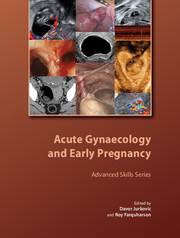Book contents
- Frontmatter
- Contents
- About the authors
- Acknowledgements
- Abbreviations
- Preface
- 1 Organisation and delivery of emergency care in early pregnancy and acute gynaecology
- 2 Epidemiology and aetiology of miscarriage and ectopic pregnancy
- 3 Diagnosis of miscarriage
- 4 Conservative and surgical management of miscarriage
- 5 Management of hyperemesis gravidarum
- 6 Diagnosis and treatment of recurrent miscarriage
- 7 Differential diagnosis and management of molar pregnancy
- 8 Drugs in early pregnancy
- 9 Diagnosis of tubal ectopic pregnancy
- 10 Conservative management of tubal ectopic pregnancy
- 11 Surgical management of tubal ectopic pregnancy
- 12 Diagnosis and management of non-tubal ectopic pregnancy
- 13 Diagnosis and management of acute pelvic pain
- 14 Management of vaginal bleeding in the acute clinical setting
- 15 Current concepts in screening and outpatient management of pelvic inflammatory disease
- 16 Diagnosis and management of haemorrhagic and septic shock
- 17 Role of minimally invasive surgery in acute gynaecology
- Index
7 - Differential diagnosis and management of molar pregnancy
Published online by Cambridge University Press: 05 July 2014
- Frontmatter
- Contents
- About the authors
- Acknowledgements
- Abbreviations
- Preface
- 1 Organisation and delivery of emergency care in early pregnancy and acute gynaecology
- 2 Epidemiology and aetiology of miscarriage and ectopic pregnancy
- 3 Diagnosis of miscarriage
- 4 Conservative and surgical management of miscarriage
- 5 Management of hyperemesis gravidarum
- 6 Diagnosis and treatment of recurrent miscarriage
- 7 Differential diagnosis and management of molar pregnancy
- 8 Drugs in early pregnancy
- 9 Diagnosis of tubal ectopic pregnancy
- 10 Conservative management of tubal ectopic pregnancy
- 11 Surgical management of tubal ectopic pregnancy
- 12 Diagnosis and management of non-tubal ectopic pregnancy
- 13 Diagnosis and management of acute pelvic pain
- 14 Management of vaginal bleeding in the acute clinical setting
- 15 Current concepts in screening and outpatient management of pelvic inflammatory disease
- 16 Diagnosis and management of haemorrhagic and septic shock
- 17 Role of minimally invasive surgery in acute gynaecology
- Index
Summary
Introduction
Molar pregnancies result from disorders of human fertilisation. They are the most common form of gestational trophoblastic disease, which incorporates a wide spectrum of abnormalities of trophoblastic development. Hydatidiform moles were first described by Hippocrates in ancient Greece. The etymology is probably derived from the Greek word hydatis meaning ‘a drop of water’, referring to the watery content of the cysts, and the Persian word mylon meaning a misshapen thing (false conception). The modern medical term hydatidiform mole refers to a disorder of placental development in which the villous mesenchyme, vasculature and trophoblast are all affected and there is little or no fetal development.
Molar pregnancies are characterised by villous hydrops. Trophoblastic hyperplasia is the characteristic microscopic feature of true molar pregnancies. Biochemical analysis of the fluid from molar vesicles indicates that it is derived from the diffusion of maternal plasma but also contains specific trophoblastic proteins. These biochemical findings suggest that the hydropic (hydatidiform) transformation of the villous mesenchyme is caused by maldevelopment, regression or lack of the villous vasculature, which compromises the drainage of fluid produced by the trophoblast. Mild to moderate generalised villous oedema, which is often found following the demise of an embryo or early fetus, supports this concept and highlights the fact that hydropic villous changes are not exclusive to molar pregnancies. Hydatidiform transformation of villi is a non-specific feature of vascular dysfunction and only the hyperplastic microscopic appearance of the trophoblast is decisive for the diagnosis of molar pregnancy. Hyperplasia can be identified histologically before the hydropic villous changes are visible macroscopically.
- Type
- Chapter
- Information
- Acute Gynaecology and Early Pregnancy , pp. 73 - 84Publisher: Cambridge University PressPrint publication year: 2011

